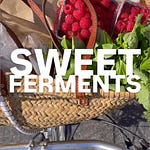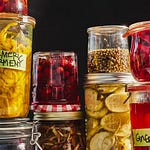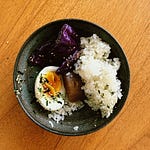Playback speed
×
Share post
Share post at current time
Share from 0:00
0:00
/
0:00
Transcript
Lesson 08
Case Study 03: Edible Flowers
May 25, 2025
Up next in the forgotten vegetables series, flowers. Are flowers vegetables? Many debate this. Lots of vegetables come from a blossom, and those blossoms are edible with nutrients. A scientist would answer the question with a hard no. But broccoli is actually a flower. Its confusing. What’s facts is that within the last ten years culinary buds, petals, pistons and blossoms have been peeking the interest of cooks, myself very much included. And each year more varieties are available to us at the markets and more of their benefits are being uncovered both medicinally and mystically.
Here in New York, the magnolia heralds in the first of the blossoms of spring. This year was the first time I tested and developed with magnolia buds. I began working with Evan, the forager again and he was bringing them from Pennsylvania.
I made a syrup using a sweet lacto-ferment, a slow process I thought would help keep the color, it turned dark but brought out a lovely aroma from them that they didn’t have fresh. So I fermented them longer until it acquired a tartness. I used it as a tea, a tablespoon or two in hot water during those early wet damp spring days in NYC. Its a beautiful mix of floral, tart & sweet that feels special and derserved when its so grey and you are with feelings. I got more the following week and made a salt , using coarse kosher salt (not kosher crystals) process them fine with the fresh magnolia buds, petals only. Using a food processor let them go until the salt becomes fine and turns purple, lay them on a rack or flat basket lined with parchment paper to dry. I also dried some petals and add a couple to a favorite tea, magnolia is known to have deep anxiety calming properties.
Cherry Blossoms, trailing right behind the magnolia in the season. I’ve been processing these by salt preserving, plum pickling then drying. When done and dried they are left coated in a salt crust. Its an annual tradition for me mostly due my obsession with its alchemic magic. I first pick the buds right before they blossom, they have no aroma outside of the scent freshly picked nature, very neutral. Within the process of salting them they release an aroma so intoxicating, they begin smelling of marzipan, a favorite sweet confectionary scent of mine or sweet almond oil. Its change from one thing to another is captivating. I wrote about the process for my friend, the poet, musician & producer Mia Moretti’s book Low Touch Economy, 2021.
Crystallization, a process originally used as a form of preservation consisted of making a sugary syrup, dipping the flowers in it then drying them so the sugar recrystallizes making a protective barrier on the flower also observed as a decorative, its a very technical process. These days its done easily by simply brushing the flowers delicately paint brushing them with slightly watered down egg whites then coating them with granulated or castor sugar. I was asked to cook a flower focused dinner once, as a dinner ending I crystalized long stems of flowering mint and hyssops and used it as a tea, visual, sweet and herbal.
Gomasio.
Another project to consider is drying them, I lay them on a drying basket or cooling rack and forget about them for a week. I’ll add a few to an herbal tea mix. Or to the Summer Gomasio on p. 106 where all my indulgent flower purchases usually end up, a beautiful sesame flourish for most foods made with sesame, salt, dried herbs and petals, it could be considered a daily condiment living permanently on your table.
Salads.
And even simpler yet but definitely a luxury shower your salad w them. They have wellness benefits but can be bitter, I love bitter when balanced with, try Shaved Mushroom, Dandelion, and Petal Salad on p. 197. Or simply have them as a stunning flourish for dips, crudos, desserts and cakes.
Or Flower Hearts with Petal Dressing, a recipe commission for Wild Minded by April Johnson aka @flowerphyscos in 2024.
Drink it.
Dandelion wine notes here with an excerpt from Edna Lewis about collecting them. Or a violet lemonade, I’m a fan of a saffron cold infusion in the summer with a drop of orange blossom water, its so quenching and transformative. Consider making kombucha this year and use rose petals. Please always make sure your petals are pesticide and chemical free.
HOMEWORK
Dry something and use it in a recipe.
Process; On a breathable surface like a flat basket, cooling rack or oven rack covered with parchment paper or a clean dish towel over top lay your clean herbs, blossoms, petals, flowering herbs or flowers. Give them a home out of the way perhaps on top of a cupboard, fridge or shelf. Always make sure ingredients are organic especially these delicate ones that can absorb a great deal of pesticides and chemicals.
Uses include; tea blend, a seasoning salt or gomasio mix.
Need a suggestion? Make a tea blend, dry lemongrass, mint and calendula or other dried flower. When using lemongrass use the top semi-dry part of the plant and reserve the dense bulb for cooking with, try Fresh Curry Paste p. 94, a flavor paste to have on deck to use as a base for curry or to slather on fish or shrimp before grilling or broiling (my new favorite everyday way to cook).
Next week
A field trip to Vieques, Puerto Rico and I’ll be announcing a group trip centered around food.
Recent Posts






























Share this post